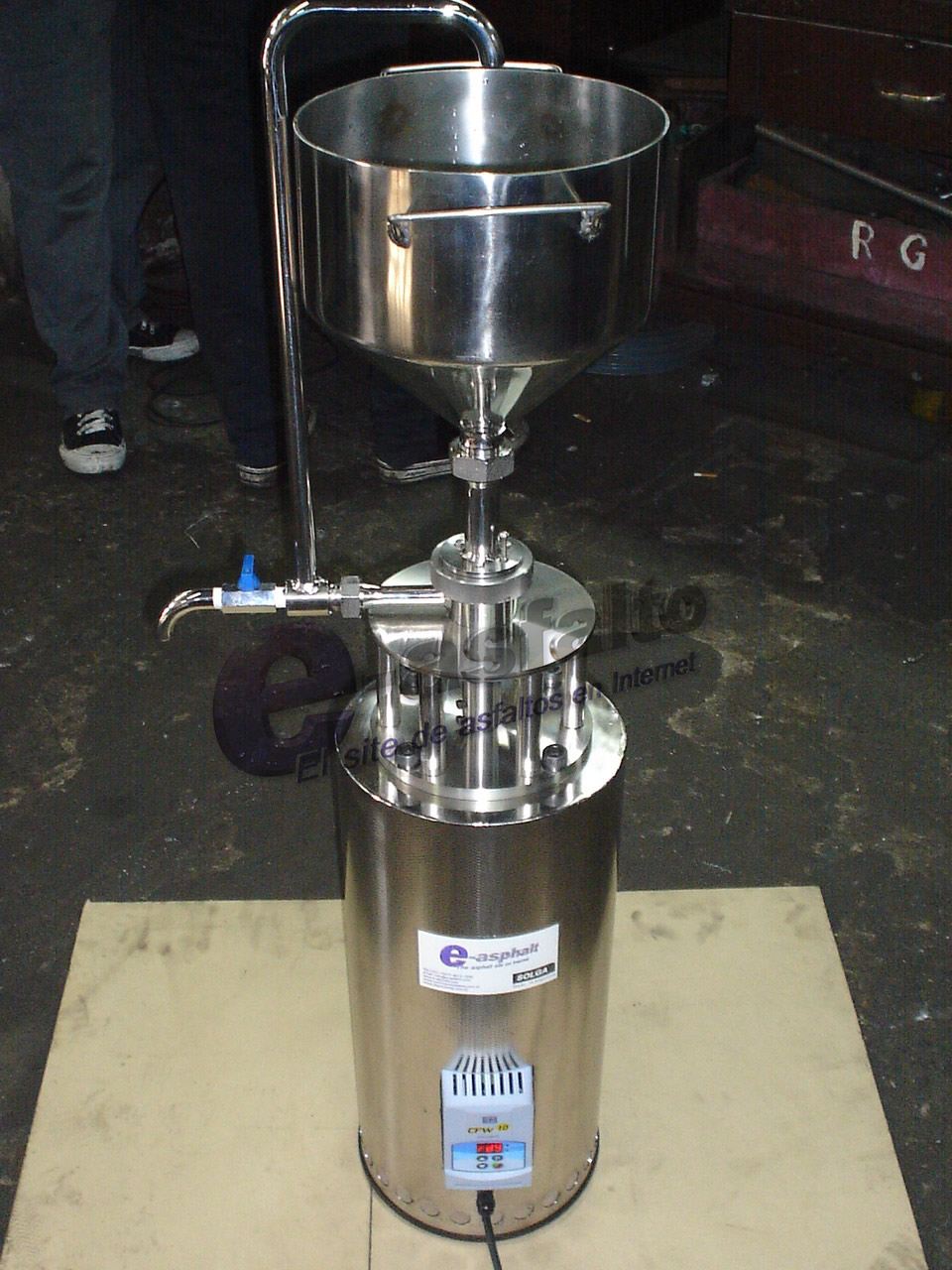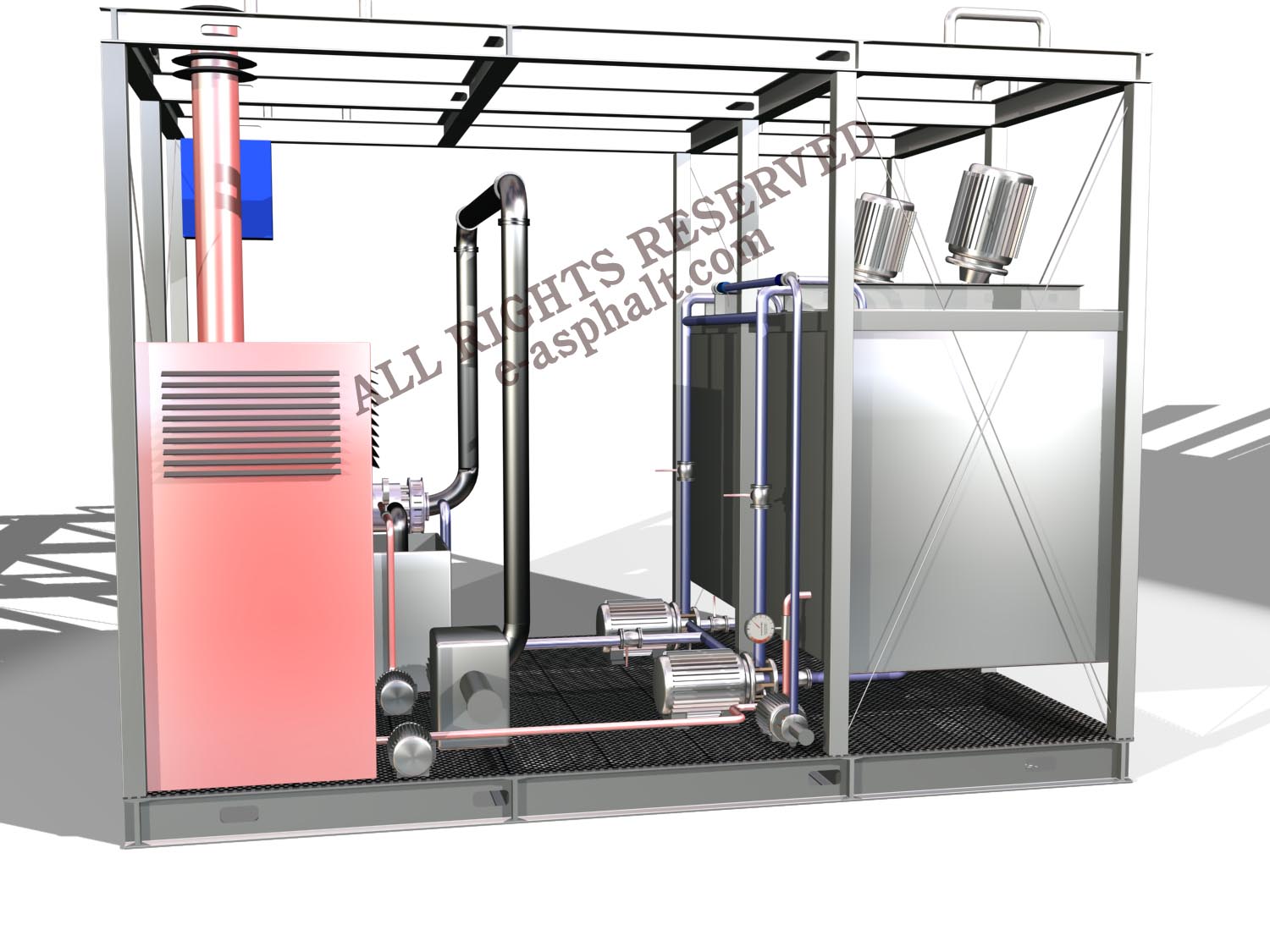Conical Colloidal Mills
Emulsion definition
An emulsion is a dispersion of two immiscible fluids in each other
generally prepared using a product called an emulsifier or an emulsifying
agent. Bitumen emulsification consists in dividing it into fine
electrically-charged particles provided with an inter-repelling capacity. |
.jpg) |
Components
|

|
Bitumen
Bitumen is produced by petroleum refineries. An additive facilitating
emulsification and improving stability and adhesion qualities is usually
incorporated by the refinery before the bitumen is delivered.
Diluents and fluxes
Diluents are generally produced by the petroleum refineries. Diluents are
low viscosity (0/1 or 10/15) used to fluidize bitumens. Fluxes are generally
coal tar oils.
Water
The selected water must contain a minimum amount of mineral and organic
impurities. In general, it is necessary to "ion exchange", the water, using
an appropriate device, to manufacture certain emulsions. Ion exchange
consists of replacing the magnesium and calcium ions contained in the water
by added sodium ions. In fact, magnesium and calcium ions tend to react, in
particular, on CnHm-COONa type emulsifiers to form compounds insoluble in
water which no longer have emulsifying properties.
Emulsifiers (or emulsifying agents)
The commonly used emulsifiers are amine class chemical products. In
particular, they are characterized by their liquid or paste-type consistency
which affects handling, storage and dosing.
Acid
As emulsifiers are insoluble in water, it is necessary to convert them
into salts so as to dissolve them in the dispersing phase. To this end, they
are reacted with an acid, more often than not, hydrochloric acid, in a
20-22° Baumé solution. |
Manufacture parameters
Dispersion energy
Emulsion dispersion is caused by mechanical energy and physicochemical
energy.
The mechanical energy divides the bitumens into fine particles and the
emulsion fineness increases with the fractioning capacity.
The physicochemical energy provided by the emulsifier must:
* reduce the interfacial tension between the hydrocarbon phase and the
aqueous phase so as to facilitate emulsification.
* create a protective film around the particles.
Component viscosity and temperature
In order to enable the hydrocarbon binder to properly disperse in the
aqueous phase it is necessary for its viscosity to be relatively low. The
optimal viscosity is 200 centipoises which is obtained by maintaining the
binder at a temperature which is a function of its penetration grade. This
temperature is approximately as follows:
Penetration
Emulsification temperature
180/220
140ºC
80/100
150°C
40/50
160°C |

 |
|
.JPG) |
If you significantly exceed
these temperatures, unwanted and undesirable effects may occur. In fact, if
at the mill outlet, the emulsion - which is at atmospheric pressure is at a
temperature greater than 95°C it "boils overs". Nonetheless, manufacture of
the aqueous phase requires that the water be at a tempeature of around 40°C
and therefore it is necessary that the binder temperature does not exceed a
certain limit.
There is one simple rule - which is mainly vallid for 60% emulsions - and
that is that the sum of the aqueous and hydrocarbon phase temperatures does
not exceed 200°C. Some emulsions must be manufactured under a pressure of a
few bars to satisfy the mandatory parameters corresponding to the components
and simultaneously prevent boiling of the aqueous phase. |
Component
dosing
Component dosing must be extremely precise, especially the emulsifiers and
the acid: a variation, even very slight, may have far reaching consequences.
Dispersing phase preparation installation
The bitumen emulsion dispersing phase consists of water and various
emulsifying agents which make up, more often than not, an amine
hydrochloride for the cationic emulsions. Depending on the manufacture mode
adopted, the dispersing phase is: |
* either in one operation: the
emulsifiers and the acid are added to the water at their exact dose,
* or in two operations:
• manufacture of a concentrated product by adding emulsifiers and acids at a
high dose rate to the water.
• dilution of this concentrate in hot water at emulsion manufacture time at a
proportion corresponding to the final dosing.
To prepare the dispersing phase, the manufacture plant is provided with the
following installations:
* dosing (by weight or by volume)
* mixing and diluting, if necessary
* water heating
Certain plants are provided with a pH meter so as to be able to continuously
check the compliance of the pH indicated and the one given by formulation,
during the dispersing phase manufacture and then the emulsion phase manufacture.
The dispersed phase may be:
* either pure bitumen
* or a blend of bitumen in predefined proportions with:
• a flux or a diluent
• other agents, for example elastomers (this concerns modified bitumens)
Also, in certain cases, the emulsifier is fully or partly incorporated with the
bitumen prior to it being emulsified. These various dispersed phase compositions
require equipment whose sophistication may vary from a simple -in-line- dosing/mixing
installation to a costly high-performance mixer installation.
Emulsifying equipment
Industrial manufacture of
emulsions uses custom-made equipment providing thorough mixing capacities
to provide varying fineness and stability dispersions. Colloid mills are
usually used to manufacture emulsions. Manufacture may also be by gradual
enriching of the dispersing phase.
There are various other types of colloid mills and their main
characteristics are:
* an adjustable or fixed air gap between the rotor and the stator. The air
gap spacing has a direct effect on the emulsion fineness.
* rotation speed which affects the size and distribution of the bitumen
particles. At certain critical speeds, decantation phenomena occur causing
a reduction in emulsion quality. |
These colloid mills operate
continuously and they are fed with the dispersing and dispersed phases by
adjustable flowrate pumps.
Certain bitumen-based emulsions have special characteristics and must be
manufactured under pressure in specially designed colloid mills. Equipment
adapted to this special emulsifying mode must be provided upstream and
downstream.
|
Portatile Asphalt Emulsion Plant

model registered ©
|
Bitumen emulsion delivery
station
Generally speaking, a plant stores the emulsions it manufactures and
therefore it must have the tanks and equipment corresponding to storage
requirements. However, for certain special manufacture runs in limited
quantities, it is preferable to directly load the emulsion in the
transporter carrying the emulsion to the job site. For bulk delivery, a
plant is provided with an appropriate number of loading stations
corresponding to its specific requirements which are all provided with the
safety devices scheduled by the legislation in force. Emulsions are less and
less frequently packaged in drums. Nonetheless, to satisfy this requirement,
the plant is provided with a drum installation and whenever necessary, a
drum cleaning plant. |
Plant laboratory
The plant is provided with inspection equipment so as to be able to carry out
the compliance tests for emulsions manufactured to set specifications,
especially with regard to water content.
See more information in:
www.colloidalmill.com
e-asphalt.com
will be happy to quote special machines or proyect plant
on receipt of details of composition of the product, etc.
More Information Send Mail to:
info@e-asfalto.com
Copyright © 200-105 | All Rigths
Reserved. | Home | Buenos Aires Argentina
TELFAX: 005411-4754-9374 / 6351-6288 (whatsapp) / 5931-8727
.jpg)


